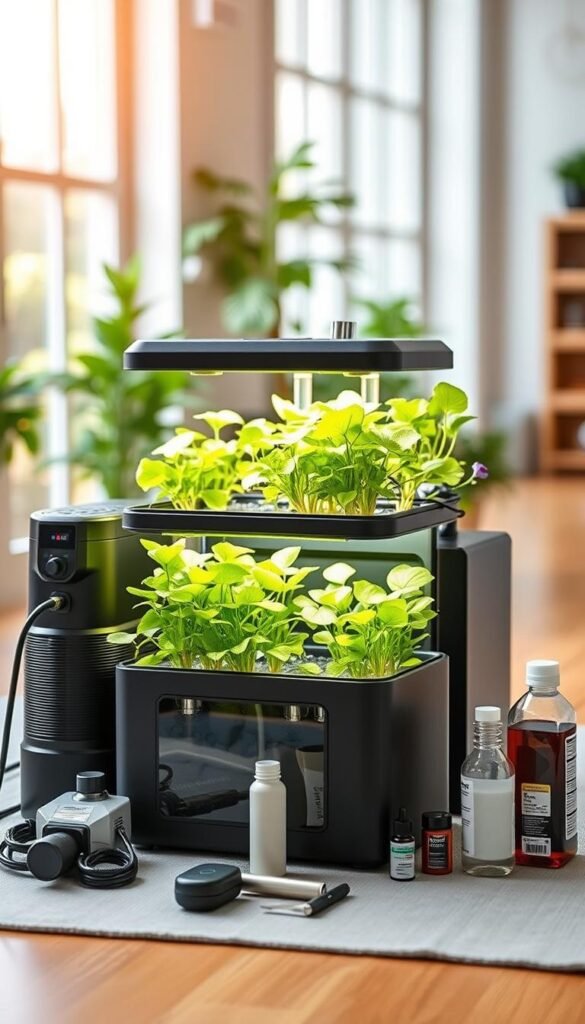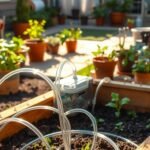Imagine growing crisp lettuce or fragrant basil without stepping outside. Modern indoor setups let you cultivate fresh greens year-round, even in tight apartments. These systems use water-based growing methods instead of soil, making them perfect for small kitchens or balconies.
Many first-time growers worry about complicated setups. But today’s kits simplify everything. Automatic watering and built-in lights handle the hard work, so you just add seeds and watch them thrive. One user shared how their countertop garden produced herbs twice as fast as traditional pots.
Why choose this approach? Store-bought veggies often face recalls or pesticide concerns. With your own setup, you control what goes into your food. Plus, brands like AeroGarden and Click & Grow include nutrient pods and smart reminders to prevent guesswork.
We’ll explore top-rated options later, including Gardyn’s space-saving vertical design. Whether you want salad greens or cherry tomatoes, there’s a system tailored to your needs. Ready to ditch the grocery store?
Understanding Hydroponic Gardening: Benefits and Basics
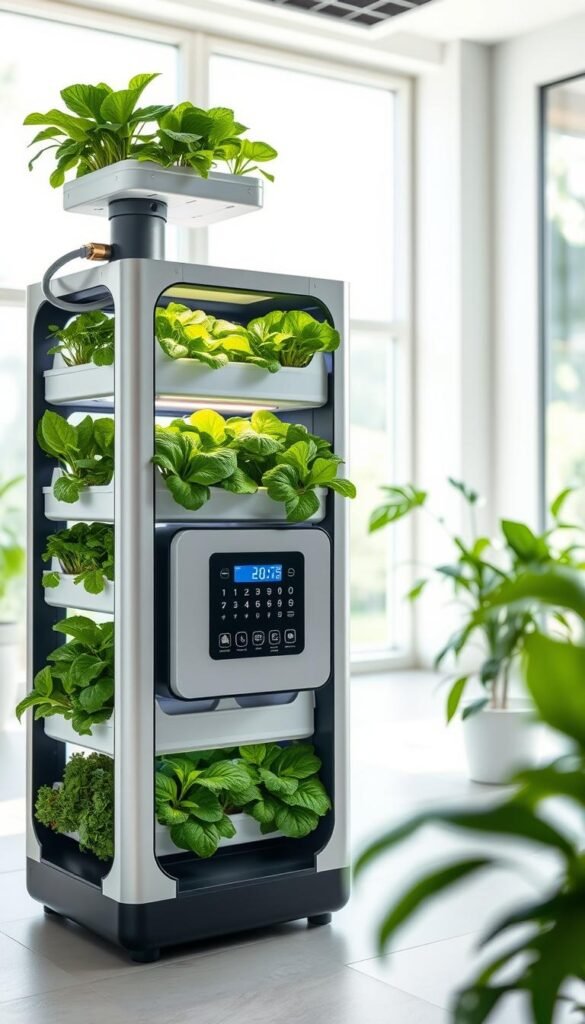
Growing fresh produce indoors might seem challenging, but modern methods simplify the process. Instead of soil, plants thrive in water enriched with nutrients. This approach lets roots absorb food directly, speeding up growth while using 90% less space than traditional pots.
Maximizing Every Square Inch
Urban dwellers love these setups because they stack vertically. A compact 18-inch tower can hold 12 plants—ideal for tight kitchens. One user transformed their studio apartment’s windowsill into a basil farm using a recirculating system.
Water Wisdom and Always-On Harvests
Closed-loop systems reuse water, cutting waste by up to 70%. No more guessing about hydration—built-in pumps deliver moisture precisely when needed. Best part? Seasons don’t matter. Grow peppermint in December or lettuce during heatwaves with consistent results.
Herbs like oregano and thyme flourish here, often ready in half the time of soil gardening. Pair that with maintenance tips for pH balance, and you’ll enjoy fresh flavors year-round without backyard space.
Hydroponic Gardening for Beginners: Starter Kits That Make It Easy
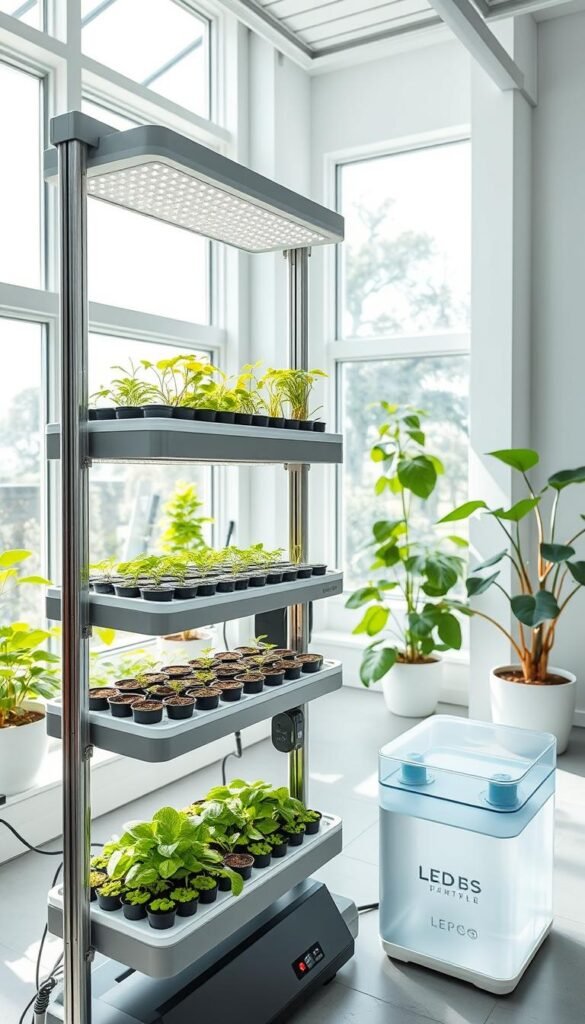
First-time growers thrive with systems that handle lighting and nutrients automatically. These all-in-one solutions remove the complexity of soil-free cultivation, letting you focus on enjoying fresh flavors rather than technical details.
Why Pre-Assembled Systems Work
New users often share how their basil sprouted three days faster than expected. One home chef reported harvesting mint weekly for cocktails using a kit with self-adjusting LED lights. The magic lies in pre-measured components—no mixing formulas or guessing growth stages.
Must-Have Components for Success
Look for these features when choosing your setup:
- Preloaded nutrient pods that release minerals gradually
- Reservoirs with water-level indicators
- Built-in timers for consistent light cycles
These elements create a stable environment for leafy greens and compact veggies. Many kits include QR codes linking to video guides, turning potential frustrations into a smooth process. You’ll notice roots developing faster as the system optimizes every variable.
Sarah from Colorado said her first harvest felt “like magic” because the kit managed pH levels automatically. Whether nurturing parsley or cherry tomatoes, these systems let you grow food confidently—no green thumb required.
Key Components of a Smart Hydroponic System
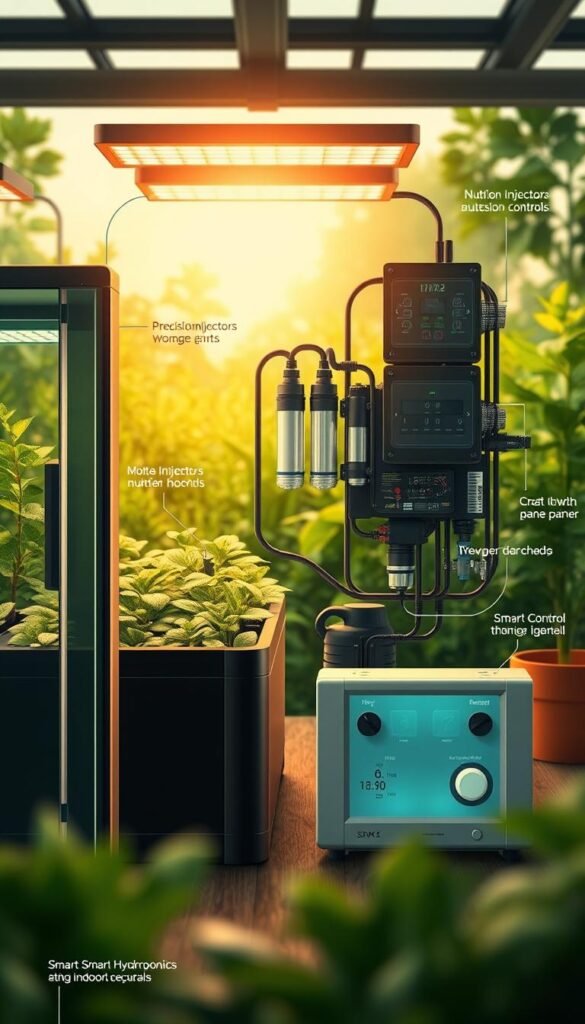
Smart systems turn your kitchen into a year-round farm. These setups blend precision technology with intuitive design, letting you grow vibrant greens without constant oversight. Three elements work together to create this effortless experience: balanced nutrition, tailored lighting, and automated care.
Nutrient Solutions and pH Management Essentials
Plants crave specific minerals to flourish. Pre-mixed nutrients dissolve in water, delivering nitrogen and potassium directly to roots. But here’s the catch: pH levels must stay between 5.5 and 6.5 for optimal absorption. Test strips or digital meters help you monitor acidity weekly.
Many kits include color-coded alerts when adjustments are needed. One user shared how their basil thrived after adding a pH-up solution—just a teaspoon made all the difference. Consistency is key for steady growth.
The Role of Grow Lights, Reservoirs, and Seed Pods
Full-spectrum LEDs mimic sunlight’s intensity and duration, encouraging leafy greens to photosynthesize efficiently. A reservoir acts as the system’s heart, pumping water through roots while conserving 60% more than traditional methods. No more overwatering!
Pre-seeded pods eliminate messy soil prep. Simply drop them into slots—they’re designed to expand as roots develop. Pair these with smart reminders for refilling nutrients, and you’ve got a foolproof way to cultivate herbs or cherry tomatoes.
Pro tips: Wipe reservoir walls monthly to prevent algae, and rotate plants under lights for even growth. These small steps ensure your indoor garden stays lush with minimal effort.
Comparing Top Hydroponic Starter Kits for Indoor Gardening
Choosing the right setup transforms your space into a lush oasis. Three leading systems—AeroGarden, Click & Grow, and Gardyn—each offer distinct approaches to soil-free cultivation. Let’s break down their strengths in design, tech features, and space management.
Overview of Popular Systems
AeroGarden’s sleek units feature adjustable LED lights and a large water reservoir. Its seed pods sit in a nutrient-rich solution, eliminating soil while boosting growth rates. Click & Grow stands out with “smart soil” technology—a spongy material that releases nutrients gradually. Their click grow smart app syncs with the garden for real-time updates.
Gardyn’s vertical tower maximizes vertical space, holding up to 30 plants in a 2-foot footprint. Built-in cameras track growth progress, appealing to data-driven growers. All three systems avoid traditional soil, but their delivery methods differ significantly.
Balancing Features and Footprint
Automatic watering varies by model. AeroGarden’s pump circulates water every 20 minutes, while Click & Grow relies on capillary action. Gardyn’s hybrid system uses both pumps and wicks. When comparing lights, AeroGarden offers customizable spectrums, whereas Gardyn uses full-spectrum LEDs at fixed heights.
Capacity matters for small spaces. AeroGarden Harvest fits 6 pods, Click & Grow’s Smart Garden 3 holds 9, and Gardyn’s 2.0 model supports 30 plants. User reviews praise Gardyn’s amount of herbs per square inch but note its higher initial cost. For simplicity, Click & Grow’s pre-loaded pods win—just insert and forget.
All models include lights on timers, but Gardyn adds voice control via Alexa. Whether you prioritize harvest amount or hands-off care, this list highlights options matching different lifestyles and kitchen sizes.
Product Spotlight: Aerogarden for Indoor Herbs and Vegetables
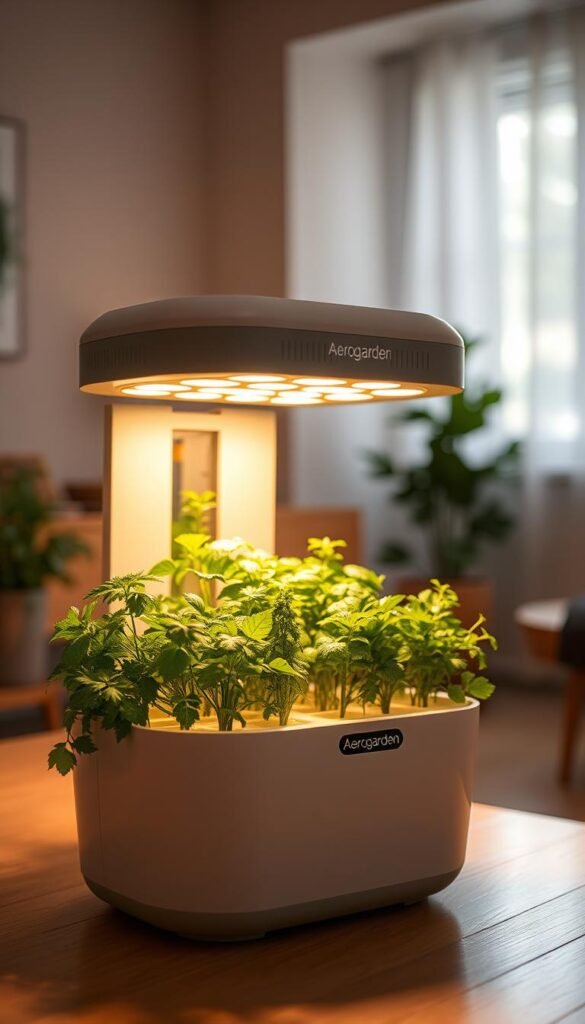
Your kitchen counter could become a fresh herb haven with AeroGarden’s sleek designs. The Bounty Elite model leads the pack, blending smart garden tech with whisper-quiet operation. Users report harvesting basil every 3 weeks—enough for weekly pesto nights.
Automated Care Meets Modern Aesthetics
This system’s genius lies in its self-watering reservoir. A pump circulates nutrient-rich water every 20 minutes, cutting usage by 60% compared to soil gardening. Busy cooks love the “set it and forget it” approach—no more wilted parsley.
Space-Smart Solutions for Urban Living
The Bounty Elite fits 9 plants in a 24-inch footprint—ideal for cramped apartments. Vertical models like Farm 24XL stack pods upward, perfect for renters with limited counter space. One New Yorker grew cherry tomatoes and thyme simultaneously using this hydroponic indoor setup.
| Model | Plants | Key Features | Best For |
|---|---|---|---|
| Harvest | 6 | Compact design | Small kitchens |
| Bounty Elite | 9 | Wi-Fi alerts | Tech enthusiasts |
| Farm 24XL | 24 | Adjustable height | Serious growers |
Why choose larger models? The Farm series includes customizable light schedules through its app—lettuce gets 15 hours daily while peppers receive 18. This precision creates faster growth rates without guesswork.
With its polished stainless steel finish and dimmable LEDs, AeroGarden turns your indoor garden into a conversation piece. As one reviewer noted: “It’s like having a produce aisle that never closes.”
Product Spotlight: Click & Grow Smart Garden for Effortless Herb Growth
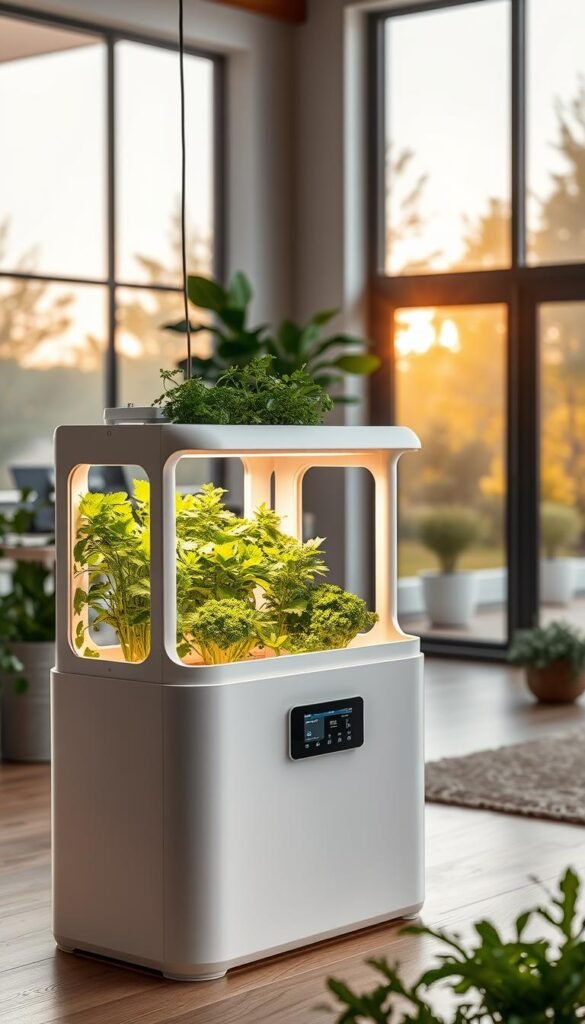
Fresh herbs at your fingertips sound like a dream, but the Click & Grow Smart Garden makes it reality. This sleek countertop system combines Scandinavian design with plug-and-play simplicity, letting you cultivate basil, mint, or parsley in weeks. Users rave about its whisper-quiet operation and modern look that blends into any kitchen décor.
Smart Features and Ease of Use for Beginners
The magic starts with pre-seeded pods containing “smart soil”—a spongy material that releases nutrients gradually. Just add water, plug it in, and watch your plants without soil thrive under energy-efficient LEDs. The built-in light timer mimics natural cycles, while the app sends reminders when it’s time to refill the tank.
Cleaning takes minutes thanks to detachable parts. One Chicago user shared: “My 8-year-old manages our thyme plant now—it’s that intuitive.” Here’s why it’s considered one of the best hydroponic options for novices:
| Feature | Benefit | User Feedback |
|---|---|---|
| Self-watering base | No over/underwatering | “Never killed a plant since switching” |
| Modular design | Expandable from 3 to 9 pods | “Perfect for testing new herbs” |
| Quiet operation | Sleep-friendly 24/7 use | “Fits in my studio bedroom” |
Considerations for Transitioning to Vegetables
While herbs flourish, larger crops like cherry tomatoes face challenges. The compact LED panel sits just 12 inches above pods—ideal for basil but restrictive for vining plants. A Seattle gardener noted their pepper seedlings outgrew the space within four weeks.
This hydroponic kit excels with leafy greens but has limits. Compare growth success rates:
| Plant Type | Avg. Height | Harvest Time |
|---|---|---|
| Basil | 10 inches | 4 weeks |
| Lettuce | 6 inches | 5 weeks |
| Tomatoes | 18+ inches | Needs transplanting |
For bigger yields, consider pairing this system with outdoor containers. As one user advised: “Use it for starter plants, then move tomatoes to deeper pots.” While not a full-scale solution, it’s a grow smart entry point into soil-free cultivation.
Exploring Gardyn: A Comprehensive Hydroponic Experience
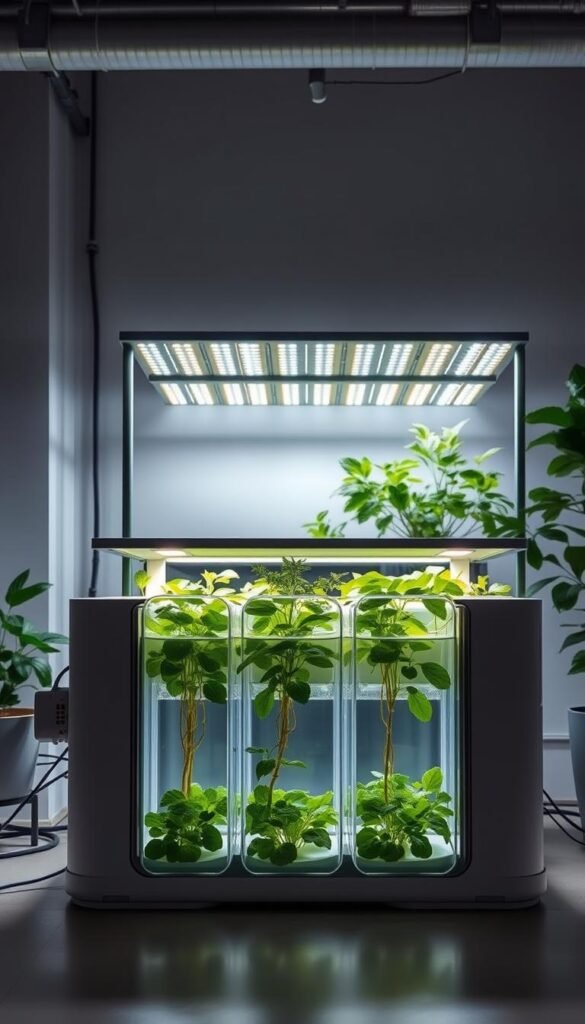
Ever wondered how a single system can grow strawberries and basil side by side? Gardyn’s vertical design merges tech-driven precision with artistic flair, letting you cultivate diverse crops in a 2-foot space. Users praise its ability to nurture everything from spicy arugula to sweet alpine strawberries—no backyard required.
Advanced Functionality and Customization Options
The grow lights adjust automatically based on plant height, ensuring each leaf gets optimal exposure. Customizable alerts ping your phone when water levels dip or nutrients need refreshing. One gardener in Arizona grew three varieties of mint simultaneously by tweaking light schedules through the app—“like having a personal botanist,” they noted.
Pre-programmed seed pods simplify starts, while open slots let you experiment with heirloom seeds. Even though setup takes 20 minutes initially, the system guides you through each step with video tutorials. Monthly memberships deliver fresh pods and pH balancers, keeping your garden thriving without store runs.
Community Insights and Long-Term Garden Management
Gardyn’s app connects you to thousands of users sharing pest-control hacks and harvest photos. A Minnesota retiree swapped tips for growing dwarf tomatoes, while a Texas chef posted basil-pruning videos. This collaborative spirit helps newcomers avoid common pitfalls.
Want to grow herbs year-round? The system’s modular design lets you rotate crops effortlessly. Replace harvested lettuce with new pods in seconds. One user reported their Gardyn produced thyme for 18 months straight—proof that the right hydroponic setup pays off long-term.
Step-by-Step Setup and Maintenance for Your Hydroponic Kit
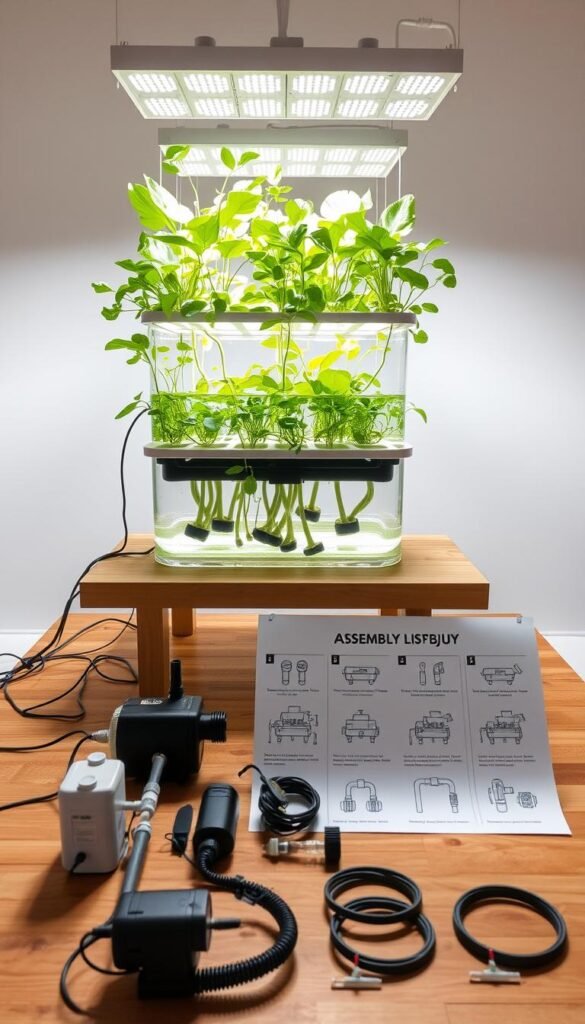
Unboxing your new setup should feel exciting, not overwhelming. Most systems assemble in under 30 minutes with basic tools. We’ll walk through installation and daily care to ensure your plant seeds become thriving greens.
Quick Assembly Tips and Installation Guidelines
Start by laying out all components: reservoir, grow lights, and seed pods. Connect the water pump to the base, ensuring tubes sit snugly. Place plant seeds or pre-seeded pods into their slots—angle them slightly for better root contact.
| Tool | Purpose | Common Mistakes |
|---|---|---|
| pH Test Strips | Check water acidity | Testing after adding nutrients |
| Measuring Cup | Mix fertilizer | Using tap water without filtering |
| Soft Cloth | Clean reservoir | Harsh chemicals damaging parts |
Position lights 4-6 inches above pods initially. One user shared how adjusting heights weekly helped their tomato plants avoid leggy stems. Fill the tank until the float indicator reaches the “max” line.
Routine Care, Troubleshooting, and Adjustment Strategies
Check water levels every 3 days—top up if needed. Change the entire solution every 2 weeks to prevent mineral buildup. If leaves yellow, test pH immediately. A Florida gardener fixed stunted basil by lowering acidity from 7.2 to 6.0.
Rotate plants under lights for even growth. For tomato plants, increase light duration to 16 hours once flowers appear. Use this way to grow robust crops:
- Germination phase: Keep humidity domes on for 5 days
- Vegetative stage: Add nitrogen-rich nutrients
- Fruiting: Boost potassium levels
Notice white roots? They’re healthy! Brown ones signal oxygen issues—add an air stone. With these steps, your indoor gardening journey stays smooth from first sprout to harvest.
Final Thoughts on Your Hydroponic Journey and Embracing Indoor Gardening
Growing fresh flavors at home might feel like a futuristic hobby, but today’s systems turn it into everyday magic. Whether nurturing peppery arugula or sweet strawberries, your space becomes a living pantry. Modern kits handle the science—you savor the results.
LED grow lights and automated care remove guesswork, letting you focus on the joy of harvests. Imagine plucking basil for dinner or sharing homegrown mint with friends. These setups prove you don’t need acres to cultivate abundance.
Start small with leafy greens or aim higher with crops like strawberries. Every harvest builds confidence. If doubts creep in, remember: communities and apps offer support. Your journey begins with one seed pod and grows from there.
Ready to start hydroponic adventures? Explore systems matching your lifestyle and space. With crisp lettuces and fragrant herbs within reach, you’ll wonder why you waited. Your kitchen’s about to become the most productive room in the house.
